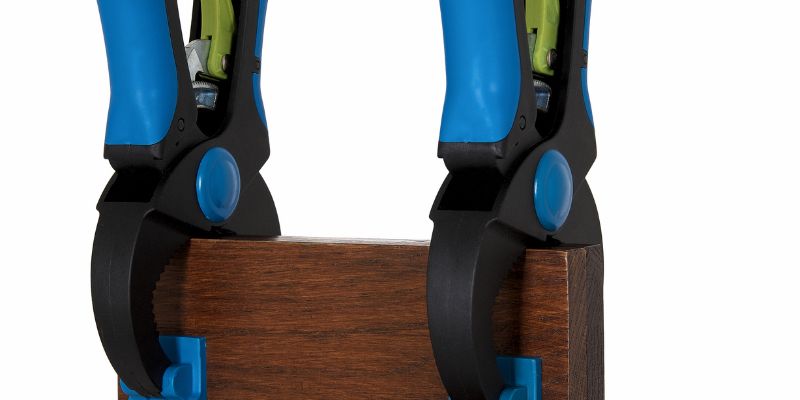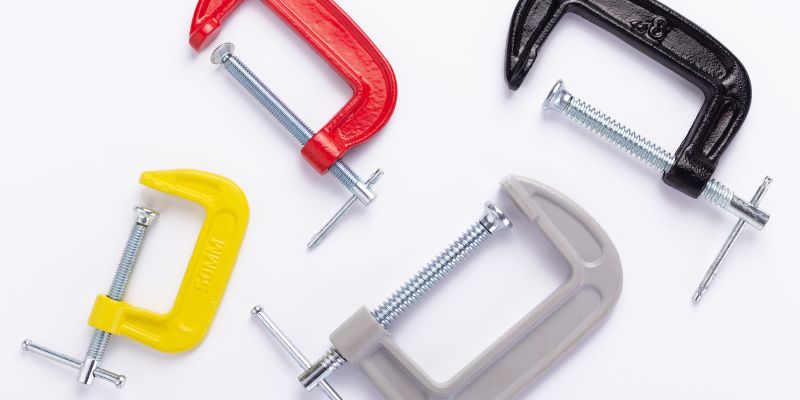Pipe clamps and bar clamps are both tools used for holding materials securely during woodworking or metalworking processes. Pipe clamps and bar clamps are essential tools for any woodworking or metalworking project, allowing users to securely hold materials in place while they work.
While both types of clamps serve the same purpose, there are some key differences between them that can impact their effectiveness and suitability for certain tasks. Understanding these differences is important for choosing the right clamp for your specific needs.
We will explore the characteristics and advantages of pipe clamps and bar clamps, helping you make an informed decision when it comes to selecting the appropriate tool for your projects. Let’s dive into the details of these clamps and explore their features, benefits, and applications.

Features And Design
Pipe clamps and bar clamps offer unique features and designs for woodworking projects. With their sturdy construction and adjustable features, both clamps provide secure and precise clamping solutions. The pipe clamp offers versatility, while the bar clamp provides strength and stability.
Choose the right clamp based on your specific project needs for optimal results.
Pipe Clamp Features And Design
Pipe clamps are versatile tools used in woodworking projects. Their design is simple yet effective, making them a popular choice among woodworkers and DIY enthusiasts. Here are some key features and design aspects of pipe clamps:
1. Construction:
Pipe clamps consist of four main components – a pipe, a sliding head, a tail vise, and a handle. The pipe acts as the main body and provides the necessary strength to hold the workpiece securely. The sliding head, also known as a clamp head, moves along the length of the pipe to adjust the clamp’s size. The tail vise holds the workpiece in place, preventing it from sliding or moving during the clamping process. Lastly, the handle helps tighten and release the clamp easily.
2. Versatility:
One of the major advantages of pipe clamps is their versatility. Pipes are available in various lengths, allowing for a wide range of clamping capacities. Woodworkers often use longer pipes to accommodate larger projects, while shorter ones are suitable for smaller pieces. In addition, pipe clamps can be used with different types of jaws, such as parallel jaws or wooden jaws, depending on the specific task at hand.
3. Pressure distribution:
Pipe clamps provide excellent pressure distribution along the workpiece. The pipe’s cylindrical shape ensures even pressure is applied, preventing any distortion or damage to the material. This feature is particularly useful when working with delicate or thin pieces of wood that require uniform pressure.
Bar Clamp Features And Design
Bar clamps, also known as F-clamps or sliding clamps, are widely used in woodworking and metalworking applications. They offer unique features and design elements that set them apart from other types of clamps. Let’s explore some of the notable features of bar clamps:
1. Design:
Bar clamps have a straightforward design comprising of a bar, a fixed jaw, a sliding jaw, and a crank handle. The bar acts as the backbone and determines the clamping capacity by allowing the jaws to slide along its length. The fixed jaw remains in a fixed position, while the sliding jaw can be adjusted based on the desired clamping size. The crank handle is used to tighten or release the clamp by exerting pressure on the sliding jaw.
2. Quick-release mechanism:
Bar clamps often come equipped with a quick-release mechanism that allows for rapid adjustments. This feature enables woodworkers to quickly reposition the sliding jaw without completely loosening the clamp. The quick-release mechanism is especially beneficial when working on multiple clamping tasks or when frequent adjustments are required.
3. Durability and strength:
Bar clamps are constructed using high-quality materials like steel or iron, ensuring durability and stability during clamping operations. The materials used in their construction make them capable of withstanding heavy pressure, making them suitable for a wide range of projects. The fixed jaw and sliding jaw have serrated surfaces that provide a firm grip on the workpiece, preventing slippage.
Overall, both pipe clamps and bar clamps offer unique features and design elements that cater to the needs of woodworkers and DIY enthusiasts. Whether you opt for the simplicity and versatility of pipe clamps or the quick-adjustment capabilities of bar clamps, these tools are must-haves in any toolbox.
Pros And Cons
When it comes to woodworking and other DIY projects, having the right clamps is essential for ensuring precise and secure workholding. Two popular options that you might come across are pipe clamps and bar clamps. Each type has its own unique features and advantages, as well as some limitations. In this article, we will explore the pros and cons of pipe clamps and bar clamps to help you make an informed choice based on your needs and preferences.
Pros Of Pipe Clamps
- Cost-effective: Pipe clamps are generally more affordable compared to bar clamps, making them a popular choice for budget-conscious woodworkers.
- Versatility: Pipe clamps can be used with pipes of various lengths, allowing for greater flexibility and adaptability in different projects.
- Strength and stability: The cylindrical shape of the pipe gives pipe clamps excellent structural integrity, enabling them to withstand heavy pressure and provide a secure grip.
Cons Of Pipe Clamps
- Heavy and bulky: Due to their construction, pipe clamps tend to be bulkier and heavier than bar clamps, which can make them less convenient to handle and store.
- Limited reach: Since the length of the pipe determines the clamping capacity, pipe clamps may not be suitable for large projects that require extensive reach.
- Difficult to fine-tune: Adjusting pipe clamps for precise pressure can be more challenging compared to bar clamps, which offer more precise adjustment mechanisms.
Pros Of Bar Clamps
- Superior reach: Bar clamps typically have longer bars, allowing for extended reach and the ability to tackle larger projects with ease.
- Ease of use: Bar clamps usually feature quick-release mechanisms or trigger handles that make them user-friendly and convenient to operate.
- Precise adjustment: Bar clamps often have fine-tuning features, such as threaded handles or pressure adjustment mechanisms, enabling precise control over clamping pressure.
Cons Of Bar Clamps
- Higher cost: Bar clamps are generally more expensive than pipe clamps, which might be a deterrent for those on a tight budget.
- Reduced strength: The longer bars of bar clamps may cause slight flexing under heavy pressure, which can lead to a less secure grip compared to pipe clamps.
- Limitation in shape clamping: Due to their design, bar clamps may have difficulty clamping irregularly shaped objects or tight spaces.
Best Applications
When it comes to woodworking and similar tasks, both pipe clamps and bar clamps are versatile tools that provide strong, reliable clamping power. However, each type of clamp has its own advantages and is best suited for specific applications. Understanding the ideal applications for pipe clamps and bar clamps can help you make an informed decision on which one to use for your project.
Ideal Applications For Pipe Clamps
Pipe clamps, as the name suggests, utilize pipes as the main clamping mechanism. These clamps are highly adjustable and known for their long reach, making them ideal for tasks that require clamping large or irregularly shaped objects. Some common applications where pipe clamps excel include:
- Gluing and clamping large panels or tabletops: Pipe clamps provide the necessary pressure and stability for keeping large pieces aligned and glued securely.
- Creating or repairing cabinets and furniture: Pipe clamps offer the flexibility to handle various joint types, such as edge-to-edge, miter, or box joints, making them a popular choice among woodworkers.
- Securing irregularly shaped objects: Due to the adjustable nature of pipe clamps, they can effectively secure objects with non-uniform shapes, such as curved or tapered pieces.
Ideal Applications For Bar Clamps
Bar clamps, also known as F-clamps, consist of a fixed bar and a movable jaw that slides along the bar. These clamps are commonly used in woodworking, metalworking, and other applications where a strong, steady grip is required. Here are some of the ideal applications for bar clamps:
- Woodworking tasks that require a high clamping force: Bar clamps are designed to provide strong, consistent pressure, making them suitable for tasks such as gluing large assemblies or laminating thick boards.
- Securing objects with parallel surfaces: The parallel jaw design of bar clamps allows them to hold objects with flat and parallel surfaces, like squaring up cabinet frames or assembling drawers.
- Metalworking tasks and welding projects: Bar clamps are often used in metalworking applications due to their ability to hold metal pieces firmly in place during welding, cutting, or grinding.
Considering the specific advantages and ideal applications of both pipe clamps and bar clamps can help you choose the right clamp for your project. By selecting the appropriate clamp type, you can ensure a secure and reliable clamping solution that meets the specific requirements of your woodworking or metalworking task.

Cost And Availability
When it comes to woodworking projects, having the right clamps is essential. Two popular options that are often compared are pipe clamps and bar clamps. In this section, we will discuss the cost and availability of these two clamp types, allowing you to make an informed decision for your next project.
Cost Comparison Between Pipe Clamps And Bar Clamps
Before deciding on which type of clamp to purchase, considering the cost is crucial. Both pipe clamps and bar clamps come in various sizes and materials, which can affect their price. Here’s a breakdown of their cost comparison:
| Clamp Type | Average Cost |
|---|---|
| Pipe Clamp | Starting from $10 |
| Bar Clamp | Starting from $20 |
As seen in the table above, pipe clamps tend to be more affordable, with prices starting at around $10. On the other hand, bar clamps typically have a higher starting cost of around $20 and can go up depending on the size and quality you require. Keep in mind that these prices are average estimates and may vary depending on the brand and location of purchase.
Availability Of Pipe Clamps Vs Bar Clamps
Availability is another aspect to consider when choosing between pipe clamps and bar clamps. Fortunately, both types are widely available and accessible, making them easy to find for your woodworking needs.
Pipe clamps can be found in most hardware stores, home improvement centers, and online retailers. They come in various lengths and sizes, ensuring you can find the right clamp for your project. Additionally, pipe clamps are often sold as individual components or in sets that include multiple clamps, giving you more flexibility in your purchase.
Similarly, bar clamps can be found in the same types of stores and online platforms. Due to their popularity and versatility, they are typically stocked by retailers. Like pipe clamps, bar clamps are available in different lengths and sizes to suit your specific project requirements.
In conclusion, both pipe clamps and bar clamps are reasonably priced and readily available, making them viable options for woodworkers of all levels. Consider your budget and project needs when choosing between the two options, and make sure to compare prices and check availability in your local stores before making a purchase.
Frequently Asked Questions On Pipe Clamp Vs Bar Clamp
What Is A Pipe Clamp Used For?
A pipe clamp is a versatile tool used to secure and hold pipes in place during various types of construction or plumbing projects. It provides stability and prevents movement, allowing for accurate and precise work. Pipe clamps are commonly used in woodworking, metalworking, and pipe installations.
What Is A Bar Clamp Used For?
A bar clamp is a handy tool used to apply pressure and hold materials together during glue-ups, woodworking, or other projects that require strong, uniform clamping. Its long steel bar provides leverage and allows for clamping larger objects. Bar clamps are essential for precise, stable, and secure work.
Can Pipe Clamps Be Used As Bar Clamps?
While pipe clamps and bar clamps have similar functions, they are designed for different purposes. Pipe clamps are primarily used for securing pipes in construction or plumbing projects, whereas bar clamps are specifically designed for clamping materials together during woodworking or glue-ups.
It is best to use each clamp type according to their intended purposes.
Conclusion
To summarize, both pipe clamps and bar clamps have their own unique advantages and disadvantages. Pipe clamps offer versatility and a larger clamping capacity, while bar clamps provide ease of use and stability. Depending on your specific project requirements, one may be more suitable than the other.
Consider factors like budget, application, and personal preference when making your decision. Ultimately, choosing the right clamp will ensure a successful and efficient woodworking experience.


